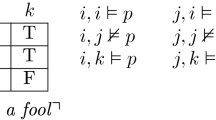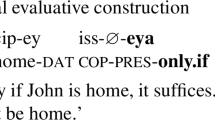Abstract
A joint modelling of objective worlds and subjective perceptions within two-dimensional semantics eliminates the margin for error principle and solves the epistemic sorites paradox. Two objective knowledge modalities can be defined in two-dimensional frames accounting for subjective perceptions: “necessary knowledge” (NK) and “possible knowledge” (PK), the latter being better suited to the interpretation of knowledge utterances. Two-dimensional semantics can in some cases be reduced to one-dimensional ones, by defining accessibility relations between objective worlds that reflect subjective perceptions: NK and PK are respectively equivalent to \({\square \square }\) and \({\lozenge \square }\) in some one-dimensional frame, and to \({\square }\) and another modality in some other.
Similar content being viewed by others
References
Bennett, B. (1998). Modal semantics for knowledge bases dealing with vague concepts. In A. G. Cohn, L. Schubert, & S. Shapiro (Eds.), Principles of knowledge representation and reasoning: Proceedings of the 6th international conference (KR-98) (pp. 234–244). San Francisco: Morgan Kaufman.
Bonnay D., Egré P. (2009) Inexact knowledge with introspection. Journal of Philosophical Logic 38(2): 179–228
Dutant, J. (2007). Inexact knowledge, margin-for-error and positive introspection. In D. Samet (Ed.), Proceedings of the 11th conference on theoretical aspects of rationality and knowledge (TARK XI) (pp. 118–124). Louvain-la-Neuve: Presses Universitaires de Louvain-la-Neuve.
Egré P., Bonnay D. (2010) Vagueness, uncertainty and degrees of clarity. Synthese 174(1): 47–78
Halpern, J. (2004). Intransitivity and vagueness. In Proceedings of the ninth international conference on principles of knowledge representation and reasoning, pp. 121–129.
Mott P. (1998) Margins for error and the sorites paradox. The Philosophical Quarterly 48(193): 494–504
Williamson T. (1994) Vagueness. Routledge, London
Williamson T. (2000a) Margins for error: A reply. The Philosophical Quarterly 50(198): 76–81
Williamson T. (2000b) Knowledge and its limits. Oxford University Press, Oxford
Author information
Authors and Affiliations
Corresponding author
Rights and permissions
About this article
Cite this article
Spector, D. Margin for error semantics and signal perception. Synthese 190, 3247–3263 (2013). https://doi.org/10.1007/s11229-012-0155-2
Received:
Accepted:
Published:
Issue Date:
DOI: https://doi.org/10.1007/s11229-012-0155-2




